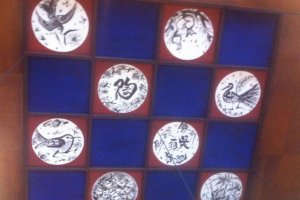When you see a line on a map, what do you see? Geometric patterns, trying to define time and space, places whose lives are reduced to lines radiating from a dot? How do we capture and visualize a country, a place, full of memories and culture, on a map?
On my map, there is a thin line going from Kyoto to Tokyo, winding through the mountains and valleys of Gifu, through towns like Magome on the way to Tokyo. In the days of old this was the Nakasendo. Merchants and pilgrims will travel on this road, some by horseback, some by foot, stopping at inns along the way. These days most people bypass the central mountains and post towns and head straight to the coast on national highway 1, a mere number devoid of the thousands of memories that were made and lost on this journey, let alone the many footsteps that have made their mark on the mud stained paths in the years past.
As you leave Kyoto on Highway 1, you go past the Gojo steps, which branches off to Kiyomizu Temple in the eastern hills, or Higashiyama in Japanese. Near Kiyomizu Temple, you can stroll the gently sloped cobbled stoned walkway and experience the roadside shops that catered for travellers in the ancient times. While I am sure many ceramics made their way to a travelers’ luggage, either as items of trade between towns or the roadside inns, or as vessels of the finest pickled vegetables to be savored after a long days hike, there is an inescapable connection between this famous pottery district and travel, as Kiyomizu yaki (pottery) is well traveled across many cities across Japan, and now the world.
Mr Naomichi Suehiro, the president of Fujihara Pottery tells me that everyone is welcome to join in the regular pottery making classes (reservations required) and discover why this pottery is so famous. When you make pottery, you are trying to give birth to what is in your mind. The lines in the soft clay, the mountains and valleys shaped by your hands are like a physical representation of your thoughts and creativity, much like the lines on a map, trying to articulate what a country looks like. You may be constrained by what you think a bowl or plate should look like, but try not to, and let your hands express what is on your mind.
If you are not ready to take the plunge in the pottery class, relax at the cafe and listen to the occasional concert series or poetry readings in this delightful cathedral to the art form of pottery. Even if you look up to the five meter high ceilings, you can see ceramics displayed, delightfully decorated with calligraphy or Kyoto wildlife. Or climb to the gallery on the second floor, where you can see ceramic paintings, all beautifully framed. Who would have thought that there were so many ways to express your creativity?
In tune with the relaxed country atmosphere, the monthly concerts revolve around jazz or classical music. During springtime, the month end concerts featured piano and saxophone, and I couldn’t think of a more pleasant way to wind down for the evening.
The cafe also showcases a list of their famous home made cakes, such as baba, a southern Italian speciality with a twist of Cointreau and orange peel, chocolate gateau and blueberry and cassis cheesecake, starting from just ¥320.































